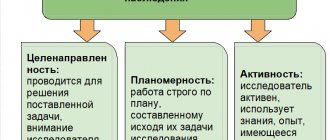The essence of the observation method
As mentioned above, the observation method is used in psychology in order to understand the behavior of a stranger . It allows you to understand whether a given object poses a threat, what intentions it has, what it is interested in, what it is striving for, etc. In other words, we can give a simple example: when a child is brought to kindergarten for the first time, he feels out of place. Like other children, due to his loneliness, he quickly finds a suitable company of children, trying to understand them. When choosing a company for himself, he understands in advance from his observations: who he likes, who poses a threat to his reputation, and who has already won attention and is a true friend.
The observation method is based on this simple example. It is very useful, because if a person does not listen to his inner feelings, determine for himself who is a friend and who is an enemy, he will quickly get lost in this world. Each person needs to know as conditions change about their essence. This applies not only to people, but also to everything of interest.
The subject of observation can be: a place, a technique, a natural phenomenon, an object and much more. The more we observe, the more information we absorb about the object, and it is by observing that we determine our desires and priorities. This has developed in humans by nature: we watch a predator on TV, and when we meet him in life, we know in advance that we should run away.
Observation can occur purposefully , for example, due to research, surveys, statistical measurements or any other purposes, and unconsciously , when we involuntarily begin to observe the object of interest. It can also vary in time:
- Episodic (occurring for a short time).
- Long-term (long-term observation time).
Or it can arise according to various criteria: a specially specified number of parameters to achieve a given goal or structured according to internal beliefs that arose without a specific goal.
Introspection
Introspection
- This is observation of oneself and the characteristics of one’s behavior. This method can be used in the form of self-control and plays a big role in psychology and human life. However, as a method, self-observation to a greater extent can only state the fact of something, but not its cause (forgot something, but it is not known why). That is why introspection, although an important research method, cannot be the main and independent one in the process of learning the essence of mental manifestations.
The quality of the method we are considering is directly dependent on a person’s self-esteem. For example, people with low self-esteem are more predisposed to self-observation. And the consequence of hypertrophied introspection can be self-digging, fixation on wrong actions, feelings of guilt, self-justification, etc.
Adequate and effective self-observation is facilitated by:
- Keeping personal records (diary);
- Comparison of self-observation with observations of others;
- Increased self-esteem;
- Psychological trainings on personal growth and development.
The use of introspection in life is a very effective way to understand yourself, the motives of your actions, get rid of some problems in life and resolve difficult situations.
EXAMPLE:
You want to increase your efficiency in daily activities (communicating with people, at work, at home) or get rid of bad habits (negative thinking, irritability, even smoking). Make it a rule to be in a state of mindfulness as often as possible every day: pay attention to your thoughts (what you are thinking about now) and your actions (what you are doing at the moment). Try to analyze what causes certain reactions in you (anger, irritation, envy, joy, satisfaction). What “hooks” do people and circumstances pull you on? Get yourself a notebook in which you will write down all your observations. Just look at what is happening inside you and what contributes to it. After analyzing after some time (a week, a month) what you have learned about yourself, you will be able to draw a conclusion about what you should cultivate in yourself and what you should start getting rid of.
Regular practice of self-observation has a very positive effect on a person’s inner world and, as a result, on its external manifestations.
Advantages of the observation method
By observing something or someone, we can benefit from it:
- Obtaining extensive data from the subject being studied . You can study an object by obtaining the widest possible amount of information about it.
- No data distortion . The more we delve into the issue ourselves, the less likely we are to receive false information. As the famous proverb says: if you want something done well, do it yourself.
- Personal participation in the process . This can be especially gratifying when the research excites the observer.
- Independence . The one who studies this object or subject is in no way connected with it and does not bear any consequences for himself. The main tool here is interest and observation, which do not cost much effort.
- Allows you to capture details and capture what you might miss.
Object and surveillance equipment
The objects of observation are individual people or many participants at once. They may belong to the same or different social groups. The subject of observation is the behavior of those being watched:
- verbal manifestations - content of conversations, intensity, duration of speech, expressiveness, vocabulary, grammatical structures;
- non-verbal manifestations - facial expression, direction of gaze, eye movements, facial expressions, gestures;
- movement - maintaining or not maintaining a distance, speed of movement or state of immobility;
- physical influence on others - blows, pushes, touches, joint efforts.
Only that which can be registered becomes the object of observation. While tracking an object, the researcher does not observe his own mental reality, but records those facts that he sees and can record. The psyche is manifested in behavior - this postulate allows the researcher to make assumptions about the mental properties of an object. The basis for the hypothesis is observational data.
The means of observation can be either the researcher himself or the auxiliary elements chosen by him:
- sound recording equipment;
- video and photo camera;
- special observation maps.
The choice of equipment for recording the situation is determined by the conditions in which it is carried out - in an isolated room, in a public place.
Disadvantages of the observation method
- The only point of view . This can be either a positive or a negative factor, but rather a negative one. This is due to the fact that one person may have a biased opinion or may not notice an important detail, which means the data will be inaccurate or isolated within one person.
- It cannot be applied to a large number of terms . Since there is often only one observer, it is possible to examine only one object or, in extreme cases, several. If a large number of objects under consideration are needed, the observer will not be able to cope with them.
- Large energy costs . For an observer, this can be a difficult task, since he will have to direct all his strength, time, and creation to a single goal. To accomplish this you need to have perseverance and common sense, which is beyond the power of energetic and motoric individuals.
- Time limit . Usually, the observer is given a limited amount of time for the task, this may affect the accuracy and correctness of data acquisition. Such an important approach to the matter must be done with a large time resource, which is not always possible.
- Intervention on the part of the researcher is possible . This can happen if he is too enthusiastic and brings personal experiences, interest, and passion for this event into the study. This can be a significant drawback, as it is easy to spoil the flow of events.
- Psychological and physical characteristics of the observer . Behavioral factors may affect the observation process; it may even be that the researcher has no interest in the object in question, it is simply necessary to complete the task as assigned. In such a situation, there may be a lack of observation, perseverance, desire to obtain information and other understandable reasons.
- Changing the observable object . Factors that can happen to the observer have already been taken into account, but what about the object itself? Something can always happen that was not within the scope of study of the subject and atypical changes have occurred that cannot allow it to be studied in the future.
Psychological observation: advantages and disadvantages
The advantages and disadvantages of a research method such as observation should be assessed in advance, at the planning stage.
The positive aspects of observation include the opportunity to:
- identify the smallest details of the issue under study, reveal its versatility;
- see and record events and behavioral manifestations directly during their occurrence;
- maintain contact between the observer and the subject, which allows you to obtain the most reliable, objective and relevant information of a social nature;
- fully understand the motives and meaning of certain behavioral manifestations in different situations, identify their impact on current events;
- maintain the researcher’s independence from the observed object, when collecting information, rely not only on the ability, but also the desire to establish contact.
Observation is a relatively inexpensive empirical method. It allows you to quickly obtain the necessary information. The study is easy to organize regardless of the willingness of one or a group of objects to participate in it.
Disadvantages of psychological observation are divided into 2 groups - objective, independent of the observer, and subjective. They are associated with personal characteristics, professional qualities of the researcher, as well as the attitudes of the experiment participants.
The objective disadvantages of observation in psychology include the following:
- the inability to use tracking often enough when it is necessary to involve a large number of people being observed;
- a limited number of studied processes and related mental phenomena, which leads to a narrowing of the ability to widely generalize the results obtained;
- the difficulty, and often impossibility, of completely repeating the study;
- the ability to draw only qualitative, but not quantitative conclusions;
- frequent occurrence of difficulties with recording and describing the phenomena under study, the need to do this part of the work after the end of the observation;
- insufficient opportunity to obtain information about the goals and reasons for recorded behavior;
- temporary limitation on the time of unfolding of the event;
- the labor-intensive nature of the method, often the need to involve a large number of highly qualified specialists in the research;
- high cost in the case of using special sound and video recording equipment.
Psychologists believe that another disadvantage of observation is that the method does not allow one to directly examine all the facts; many areas are inaccessible for research in this way.
Among the subjective disadvantages:
- the researcher's ability to influence the situation;
- the risk of introducing a subjective opinion or attitudes during the interpretation of the received material, which entails an incorrect interpretation, a discrepancy between the obtained result and the real situation;
- unequal social status, cultural differences, dissimilarity in behavioral stereotypes and life positions of the researcher and the subject can affect the interpretation and distort the result;
- The researcher’s personality traits may affect his perception of the observed situation, which reduces the quality and reliability of the method. For example, if a specialist develops a feeling of condescension towards an object, it is possible to obtain an exaggeratedly positive result. If a psychologist is unconsciously inclined to see the contrast of the participants in the experiment, then he can ignore their characteristic character traits and behavioral manifestations and notice only those that coincide with his perception.
At a certain moment, a psychologist can leave the observer’s position and become involved in the situation. This is fraught with the fact that he will lose the opportunity to objectively assess what is happening.
If the researcher, even before the start of the experiment, has a clearly formed opinion regarding the subject of the study, this may cause the formation of a certain point of view on the situation. Expectation often arises if the researcher has had contact with the person being observed before the experiment. In such a situation, a shift in emphasis during observation is possible.
Psychologists may make mistakes during observation. They, like the problems listed above, arise in the absence of personal therapy and supervision from a specialist. The most common mistakes are:
- Averaging is the fear of making an extreme judgment. It is based on the belief that extreme behavioral manifestations are much less common than low- and moderate-intensity ones. Avoiding polar assessments, researchers average them and make the results uniform. Using a wide range of estimates when studying the intensity of behavioral manifestations helps to avoid this. A psychologist prone to averaging needs to identify in himself the reason for excessive indulgence (it can be provoked by self-doubt, poor knowledge of the subject of research).
- Incorrect modeling, in which the researcher uses deduction, is confident that some personality traits are interrelated or contradict each other. Arranging a “logical” conclusion according to the type: a friendly person is good-natured, a good-natured person is trusting or eloquent, an eloquent person is well-educated and educated, an educated person is eloquent, leads to an erroneous result.
The psychologist’s mood during observation can leave an imprint on his perception of the situation, as well as distort the result of the experiment.
The disadvantages of psychological tracking can be overcome by carefully thinking through the program and thoroughly preparing for the work of collecting the necessary information. Monitoring the progress of work by the study organizers also helps to cope with difficulties.
Irina Sherbul
Reinforcement
Reinforcements
is the instant reaction (positive or negative) of the researcher (or the environment) to the actions of the subject. The reaction must actually be instantaneous, so that the subject immediately has the opportunity to associate it with his action. If the reaction is positive, then this is a sign that you should continue to do or act in a similar way. If the reaction is negative, then vice versa.
Reinforcement can be of the following types:
- Positive - correct behavior/action is reinforced;
- Negative - incorrect behavior/action is prevented;
- Conscious;
- Unconscious;
- Natural - happens by accident (burn, electric shock, etc.);
- Intentional - conscious action (education, training);
- One-time;
- Systematic;
- Direct;
- Indirect;
- Basic;
- Secondary;
- Full;
- Partial.
Reinforcement is a huge part of human life. It, like suggestion, has been present in her since childhood in the process of upbringing and gaining life experience.
EXAMPLE:
Examples of reinforcement are around us at every step: if you put your hand in boiling water or try to touch the fire, you will certainly get burned - this is negative spontaneous reinforcement. The dog, following some command, receives a treat and repeats it with pleasure - positive intentional reinforcement. A child who gets a bad grade at school will be punished at home, and he will try not to give any more bad grades, because if he does, he will be punished again - one-time/systematic negative reinforcement. The bodybuilder knows that only regular training will give results - systematic positive reinforcement.
Psychological testing
Psychological testing
belongs to the section of psychodiagnostics and deals with the study of psychological qualities and personality traits through the use of psychological tests. This method is often used in counseling, psychotherapy, and by employers when hiring. Psychological tests are needed when you need to learn about a person’s personality in more detail, which cannot be done through a conversation or survey.
The main characteristics of psychological tests are:
- Validity is the correspondence of the data obtained from the test to the characteristic for which the test is carried out;
- Reliability – consistency of the results obtained during repeated testing;
- Reliability is the property of a test to give true results, even with intentional or unintentional attempts to distort them by the subjects;
- Representativeness - compliance with norms.
A truly effective test is created through trial and modification (changing the number of questions, their composition and wording). The test must go through a multi-stage verification and adaptation procedure. An effective psychological test is a standardized test, based on the results of which it becomes possible to assess the psychophysiological and personal characteristics, as well as the knowledge, skills and abilities of the subject.
There are different types of tests:
- Career guidance tests - to determine a person’s predisposition to any type of activity or suitability for a position;
- Personality tests - to study character, needs, emotions, abilities and other personality traits;
- Intelligence tests - to study the degree of development of intelligence;
- Verbal tests - to study a person’s ability to describe actions performed in words;
- Achievement tests - to assess the level of mastery of knowledge and skills.
There are other test options aimed at studying a person and his personality traits: color tests, linguistic tests, questionnaires, handwriting analysis, psychometrics, lie detector, various diagnostic methods, etc.
Psychological tests are very convenient to use in everyday life in order to better know yourself or the people you care about.
EXAMPLE:
Tired of making money in a way that does not bring moral, psychological, or emotional satisfaction. Dreaming of finally quitting and doing something else. But you don’t know what. Find some career guidance tests and test yourself. It is quite possible that you will learn some things about yourself that you had no idea about before. The results of such tests can help you discover new facets of yourself and will help you understand what you would really like to do and what you are inclined to do. And knowing all this, it is much easier to find something you like. In addition, this is also good because a person, doing what he loves and enjoying it, becomes happier and more satisfied in life and, on top of everything else, begins to earn more.
Psychological testing promotes a deeper understanding of yourself, your needs and abilities, and often indicates the direction for further personal development.
Survey
Survey
- a verbal-communicative method, during which interaction occurs between the researcher and the person being studied. The psychologist asks questions, and the subject (respondent) gives answers to them. This method is considered one of the most common in psychology. The questions in it depend on what information is required to be obtained during the study. Typically, a survey is a mass method because it is used to obtain information about a group of people rather than about one person.
Surveys are divided into:
- Standardized - strict and giving a general idea of the problem;
- Non-standardized ones are less strict and allow you to study the nuances of the problem.
In the process of creating surveys, the first step is to formulate program questions that can only be understood by specialists. After this, they are translated into survey questions that are more understandable to the average person.
Types of surveys:
- Written allows you to gain superficial knowledge about the problem;
- Oral - allows you to penetrate into human psychology more deeply than written;
- Questioning - preliminary answers to questions before the main conversation;
- Personality tests - to determine the mental characteristics of a person;
- An interview is a personal conversation (also applies to the conversation method).
When writing questions you need to adhere to some rules:
- Separateness and conciseness;
- Exclusion of specific terms;
- Brevity;
- Specificity;
- No hints;
- Questions require non-standard answers;
- Questions should not be off-putting;
- Questions should not suggest anything.
Depending on the tasks assigned, questions are divided into several types:
- Open - offering answers in free form;
- Closed - offering prepared answers;
- Subjective - about a person’s attitude towards something/someone;
- Projective - about a third person (without indicating the respondent).
A survey, as already mentioned, is most suitable for obtaining information from a large number of people. This method allows you to determine the needs of the masses or determine their opinion on a specific issue.
EXAMPLE:
You are the director of a company providing any services and you need to find out the opinions of your employees on improving working conditions and attracting more clients. In order to do this as quickly and as efficiently as possible, you can draw up (for example, together with a staff analyst) a series of questions, the answers to which will help you solve your problems. Namely: to make the work process of employees more pleasant for them and to find some ways (possibly very effective) to expand the client base. Based on the results of such a survey, you will receive information on very important points. Firstly, you will know exactly what changes your employees need so that the atmosphere in the team becomes better and work brings positive emotions. Secondly, you will have a list of all possible methods to improve your business. And thirdly, you will probably be able to identify a promising and promising person from the total mass of employees who can be promoted, thereby improving the overall performance of the enterprise.
Surveys and questionnaires are a great way to obtain important and relevant information on current topics from a large number of people.
Psychological consultation
Psychological consultation
- this is, as a rule, a one-time conversation between a psychologist and a client, orienting him in the current life situation. It implies a quick start to work, because... The client does not need any special preparation and the specialist, together with him, can understand the circumstances and outline steps to achieve the desired result.
The main problems for which people seek advice from a psychologist are:
- Relationships - jealousy, infidelity, communication difficulties, raising children;
- Individual problems - health, bad luck, self-organization;
- Work - dismissal, intolerance to criticism, low wages.
Psychological consultation consists of several stages:
- Contact;
- Request;
- Plan;
- Setting up for work;
- Implementation;
- Hometasks;
- Completion.
The method of psychological consultation, like any other method of psychology, consists of a combination of both theoretical and practical research methods. Today, there are various variations and types of consultations. Turning to a psychologist for help can be a solution to many life problems and a way out of difficult situations.
EXAMPLE:
The impetus for resorting to psychological consultation can be absolutely any life situation that a person cannot cope with on his own. These include problems at work, troubles in family relationships, depression, loss of interest in life, inability to get rid of bad habits, disharmony, struggle with oneself and many other reasons. Therefore, if you feel that you have been overcome and disturbed by some obsessive thoughts or conditions for a long period of time and you understand that you cannot cope with it alone, and there is no one nearby who could support you, then without a shadow of a doubt and embarrassment, seek help from a specialist. Today there are a huge number of offices, clinics and psychological assistance centers where experienced, highly qualified psychologists provide their services.
This concludes our consideration of the classification of the main methods of psychology. Other (auxiliary) methods include: the method of experimental psychological tests, the method of explanation and teaching, training, coaching, business and role-playing games, counseling, the method of correcting behavior and condition, the method of transforming living and working space and many others.
Any mental process must be considered by psychological science as it really is. And this presupposes its study in close connection with the surrounding world and the external conditions in which a person lives, because they are reflected in his psyche. Just as the reality around us is in constant movement and change, its reflection in the human psyche cannot be unchanged. In order to learn to more deeply understand the features of a person’s inner world, and the essence of things in general, one should come to the realization of the fact that one of the foundations of this understanding is precisely human psychology.
Nowadays, an incalculable amount of materials for studying psychological science and its features is freely available. In order for you not to get lost in all this diversity and know where to start studying, we suggest you familiarize yourself with the works of such authors as A. G. Maklakov, S. L. Rubinstein, Yu. B. Gippenreiter, A. V. Petrovsky, N. A. Rybnikov, S. Buhler, B. G. Ananyev, N.A. Loginova. And right now you can watch an interesting video on the topic of psychological methods:










